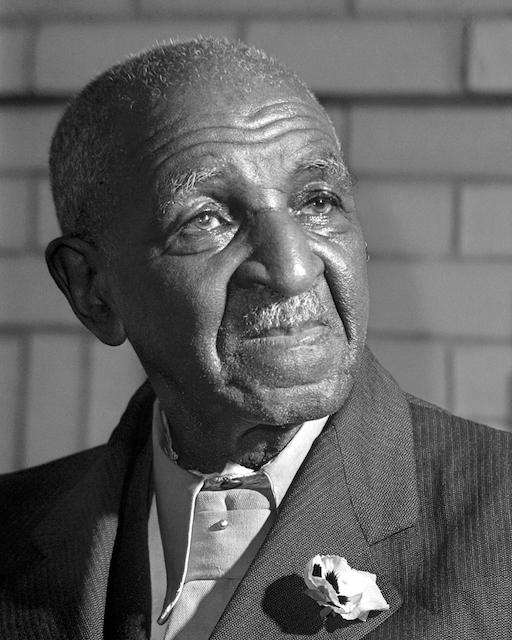
A portrait of George Washington Carver from the U.S. Farm Security Administration in March 1942. Carver enrolled at Simpson College in 1890. “At Simpson the kind of people there made me believe that I was a human being,” Carver said.
Jan/Feb 2023 (Volume 15, Issue 1)
(Publisher’s note: The Iowa Department of Cultural Affairs is commemorating George Washington Carver, the son of a slave who became one of the greatest agricultural scientists of his time and was educated at Simpson College and Iowa State, with a “Day of Learning” on Feb. 1, which is designated by the state as George Washington Carver Day. Iowa History Journal is participating in the celebration of Carver by sharing its Jan/Feb 2023 cover story about Carver’s education, work and legacy in Iowa.)
By John Skipper
George Washington Carver, a brilliant, ambitious son of a slave, who had to navigate through life in a white man’s world, emerged to be one of the greatest agricultural scientists of his time, admired and respected by people all over the world.
It is likely none of his success would have occurred had it not been for mentors at two Iowa universities who saw his potential and encouraged him.
Carver is most notably remembered for his research on the benefits of cash crops, of rotating crops, and in the intrinsic nutritional value of peanuts and other agricultural products.
His reputation was so heralded that he was credited with many innovations that were not his but his friends and associates said he never did much to squelch the acclaims.
There is no truth to the persistent rumor that he invented peanut butter. He didn’t. But he did invent his middle name.
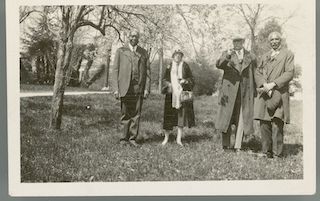
Tuskegee Institute President Robert R. Morton, Mrs. Augusta Pammel, Louis H. Pammel and George Washington Carver (left to right) in 1928. Photo courtesy of Iowa State University Library Special Collections and University Archives
Carver, who was born into slavery in Missouri, was the first black student admitted to Iowa State Agricultural College (now Iowa State University) in Ames. He later became the first black graduate student and faculty member at the university. But his successful academic and professional career at Iowa State would not have occurred had it not been for the encouragement of a teacher at Simpson College in Indianola who recognized Carver’s talent and interest in plants and flowers and suggested he enroll at Iowa State to study botany. The suggestion and his following up on it changed his life and started him on a magnificent career.
But it wasn’t easy. Folklore is filled with rags-to-riches stories but in Carver’s case, it is true.
Carver is believed to have been born in 1864 to slave parents in Diamond Grove, Mo., which is now known as Diamond, Mo. The date of his birth is uncertain — Carver himself didn’t know it — because it was not properly recorded, a common occurrence with slave children.
George’s parents, Giles and Mary, had been purchased by Moses Carver, a German immigrant, from William McGinnis for $700 in 1855. Giles died before George was born, meaning his mother, brother and sister had to fend for themselves in hard times. And the hard times started right away.
When George was just a few days old, he and his family were kidnapped by white night raiders and hustled off to Arkansas. Moses Carver hired a detective named John Bentley to find the family and bring them back. Bentley learned that George’s brother James had escaped but the others had been taken to Kentucky where they were sold. Bentley found the infant George and negotiated for his release but George’s mother and sister were missing and never found.
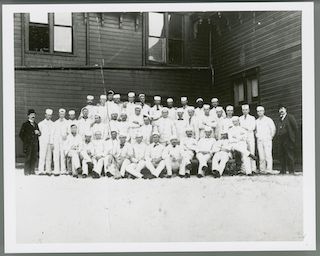
This 1894 photograph of a Creamery Operators Class at Iowa State Agricultural College includes George Washington Carver in the back row. Photo courtesy of Iowa State University Library Special Collections and University Archives
Bentley also found James and brought him and George back to Missouri. When slavery was abolished in the state in 1865 after the American Civil War, Moses Carver and his wife, Susan, raised the two boys as their own children.
Black children were not allowed to go to the public school in Diamond Grove so Susan Carver taught the boys how to read and write. It was apparent that even at a young age, and deprived of a traditional elementary school education, young George was intelligent, curious and ambitious.
He took the initiative to try to go to school a few miles away in Neosho. He arrived after the school was closed for the day so he took refuge in a barn where he slept overnight. The next morning, as he told the story later in his life, he met a woman named Mariah Watkins who rented a room to him and treated him well.
Carver said he told her his name was “Carver’s George,” the way he always identified himself. Watkins told him that from that day on, his name would be George Carver. As a young teenager, George moved from one community to another and one school to another, eventually moving in with a foster family in Fort Scott, Kan. It was there that he saw a black man savagely murdered by a group of whites, prompting him to make yet another move. He graduated from high school in the little town of Minneapolis, Kan.
There was another fellow by the name of George Carver in Minneapolis, causing confusion with, among other things, delivery of mail to the proper Carver. So George decided to add a middle initial to his name and randomly picked the letter “W.” One day someone asked him if the W stood for “Washington” and George reportedly answered “Why not?” So he became known as George Washington Carver, with the middle name he had invented, though he never signed anything using the middle name.
Carver spent much of his teenage years as a loner, making his way from one place to another, attempting to find roots — something he had never really had from the time he was born. Often hitching rides on covered wagons and doing chores as a method of paying his way, he went from one small town to another. He also was intent on pursuing an education. In 1884, he wrote to Highland University in Highland Kansas and was approved for admission — until he showed up in person and was rejected because he was black.
His next stop was to Eden Township in Ness County, Kan., where he homesteaded some land owned by J.F. Beeler, a farmer who picked up Carver on a roadside and befriended him.
Carver worked hard, manually plowing 17 acres for Beeler and planted rice, corn, fruits, forest trees and bushes, self-educating himself on agricultural wonders.
In time, he had saved a little money and was able to obtain a $300 bank loan to be used for his education. In 1890, it was time for young George to make another move, this time to Iowa where he enrolled at Simpson College in Indianola where he studied art and piano. It was here that he met Etta Budd, a life-changing experience for him. Budd, an art teacher, recognized George’s talent for painting flowers and plants and encouraged him to enroll at Iowa State Agricultural College in Ames to study botany.
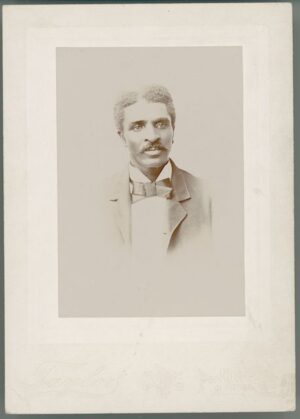
George Washington Carver’s graduation photograph from Iowa State Agricultural College which was taken in 1893 though Carver graduated in 1894. Photo courtesy of Iowa State University Library Special Collections and University Archives
In Ames, he was finally at a place where his potential was obvious and he had mentors to guide and encourage him. It was as if at long last, he had found a home. Carver became involved with the local YMCA and the campus debate club and was a trainer for sports teams, captain of a campus military regiment and employee of a dining hall. He wrote poetry for the school newspaper and excelled at painting. None of that got in the way of his first love, the study of plants and animals.
He graduated with a degree in agriculture in 1894 and provided a hint of his future research with a thesis titled “Plants as Modified by Man.” He went on to graduate school at the insistence of Louis Pammel, a professor and two-time president of the Iowa Science Academy, with whom Carver developed a friendship for most of the rest of his life. Pammel and others convinced George to go to graduate school which gave him an opportunity to work with Pammel at a scientific laboratory known as the Iowa Experiment Station. His graduate work in botany gained him national recognition. Carver received his master’s degree in 1896 and then became the first black faculty member at Iowa State.
His academic and scientific work in Ames drew the attention of Booker T. Washington, the president of the Tuskegee Institute (now Tuskegee University) in Alabama who hired Carver to be the head of the school’s Agriculture Department.
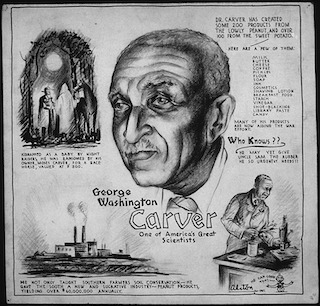
George Washington Carver, “One of America’s great scientists,” featured on a U.S. World War II poster in 1943. Photo courtesy of the National Archives and Records Administration
Washington was a prominent educator, author and orator, a no-nonsense, sometimes controversial leading voice of black America toward at the end of the 19th century and into the new century. His knowledge of government and his persuasive personality drew the attention of many politicians, including several U.S. presidents.
He was an advocate of black progress through education, business prowess and civic involvement as a way of challenging segregation in the South. At Tuskegee, he could be a tough task-master and occasionally clashed with the ambitious young man he hired to run his agriculture department.
Carver taught at Tuskegee for 47 years, under three college presidents, and developed a nationally-recognized research program. He taught his students the value of crop rotation and the importance of developing alternative cash crops in addition to the ones they were already cultivating. The value of systematic crop rotation and alternating cotton crops with plantings of peanuts or soybeans or sweet potatoes was that it restored nitrogen to the soil — which was good for the soil and eventually good for human consumption.
One of his innovations was a mobile classroom in which he brought education to farmers who were unable to come to school at Tuskegee.

George Washington Carver works in his laboratory at the Tuskegee Institute in Alabama. Photo by VCG Wilson/Corbis via Getty Images
Carver’s ego nearly got the best of him several times. One of his duties was to be administrator of some farmland used for experiment with the hope of generating revenue for the institute. But Carver balked at all the paperwork involved that took him away from his research.
Later, in an unrelated matter, colleagues accused him of exaggerating the yields achieved in a poultry program he was leading. In all, Carver threatened to resign several times during his early career at Tuskegee but Washington always managed to talk him out of it.
Washington died in 1915. In his memoirs, published in 1911, he wrote that Carver, despite the squabbles over the years, was “one of the most thoroughly scientific men of the Negro race with whom I am acquainted.”
Carver is perhaps best known for his research on the value of peanuts through all of their uses which had never before been considered or researched. He conducted similar research on pecans, soybeans and sweet potatoes. By the time he spoke to the national convention of the Peanut Growers Association in 1920, he was considered one of the leading agriculture experts in America. A year later, he testified before the U.S. House Ways and Means Committee in support of a tariff on imported peanuts. It was unusual for a black man to testify before a congressional committee and several southern legislators scoffed at the idea. But Carver, with a high-pitched voice that he had all his life, testified and Congress eventually approved the tariff.
Carver never married, apparently too busy with the passion of his work to engage in any other serious courtships. But he was a devout Christian and had no trouble explaining his devotion to both God and science. He said his faith in Jesus Christ was the guiding force in allowing him to pursue all that science had to offer. At Tuskegee, he was as interested in developing his students’ character as he was their intellectual qualities. He said there are eight “cardinal virtues” that are essential for men and women.
• Be clean both inside and out.
• Who neither looks up to the rich or down to the poor.
• Who loses, if need be, without squealing.
• Who wins without bragging.
• Who is always considerate of women, children and old people.
• Who is too brave to lie.
• Who is too generous to cheat.
• Who takes his share of the world and lets other people have theirs.
In his later years, with his work recognized throughout the world but his ego still intact, Carver passed the baton to younger generations to continue his work while he accepted invitations to speak and be honored by many admiring organizations.
In January of 1943, he tumbled down a flight of stairs in his home and was discovered unconscious by a maid. He was rushed to a hospital but died on Jan. 5 of complications resulting from the fall. He was 79. Carver was buried next to Booker T. Washington at Tuskegee University. His gravestone reads: “He could have added fortune to fame but caring for neither, he found happiness and honor in being helpful to the world.”
He is remembered today for his many accomplishments, including, in addition to his research, the many articles and bulletins he wrote to improve the livelihood of farmers and the lives of people all over the world. Perhaps his most famous bulletin, and most fitting considering his devotion to his work, was titled, “How to Grow the Peanut and 105 Ways of Preparing it for Human Consumption.”
But his Sunday School students in Tuskegee, more than a century ago, remembered him for more than peanuts. He is said to have told them, “When you do the common things in life in an uncommon way, you will command the attention of the world.”
FOR OTHER FASCINATING STORIES ABOUT IOWA HISTORY, subscribe to Iowa History Journal.
